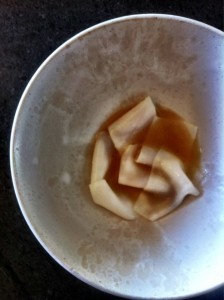I have chastised myself in these digitized words before for losing my chops/creativity/vigor for talking food and cooking. This is my choppy way of re-visiting that.
I may just post menu items. I may spill a few words about them. I may talk a little technique. No rules. Just a mess of food. I reserve the right to edit on a whim.
I’m fascinated with the Curnosky meaning behind “Make food simple and let them taste for what they are”. This can be interpreted a few different ways as extravagantly as the former El Bulli’s pea spheres (liquefied essence of sweet pea formed in amalgamate into….you guessed it, a pea) or as simple as doing as little as possible with a food in its raw form and letting it stand on its own virtues. An oversimplified example of this would possibly be unpasteurized apple cider. Press, drink, colon cleanse. The essence of the apple.
I think as a group, that the Nordic countries are embracing this and I’m sure it is no coincidence that some of the best new chefs in the world are cutting their teeth in Denmark, Sweden, Finland, etc. Wondering how much the short growing season plays a part in the sense of urgency of capturing the essence of something fresh when its availability is fleeting? And by contrast, how utilized is the preserving grace of the bracing cold?
Some things I’ve seen from them:
Lightly poached potato (still crunchy, perhaps?) with seaweed sauce and pecorino cream. How often to we take the lowly potato for granted and boil the jeepers out of it or fry crunch out of it. I remember as a farm kid slicing fresh potatoes, salting and eating. Preserve the essence of the item.
An excerpt from this link at Food&Wine
“A meal at Noma is a flurry of precisely composed dishes that incorporate both familiar and wholly exotic ingredients, like musk ox or wild plants (in warm months, the cooks make frequent expeditions to the woods and the beaches, sometimes foraging with a naturalist for herbs and seaweeds). Redzepi says, “The taste of Noma is light, subtle. Clean. The flavor shouldn’t hit you in the face—you have to taste the food and find the flavors yourself.”
(NOMA is on my bucket list of eating adventures should anyone want to get an early jump on Christmas gifts. No pressure.)
Fresh fish, smoked fish, red fish, raw fish. Nettles, seaweed, juniper and other aromatic berries not indigenous to North America. Schnapps, dairy (cow, goat, sheep), reindeer, musk ox. This are the flavor profiles that this group working with
This is a dish from NOMA. So simple.


